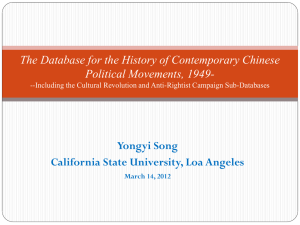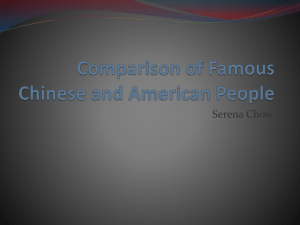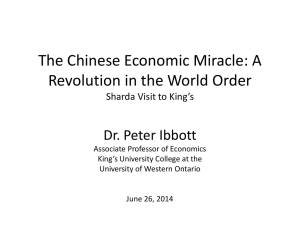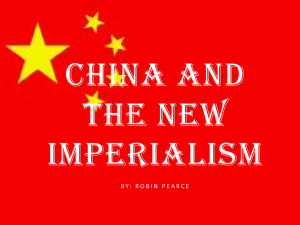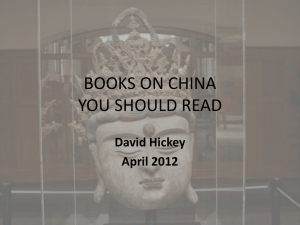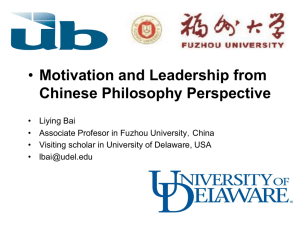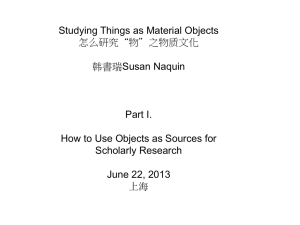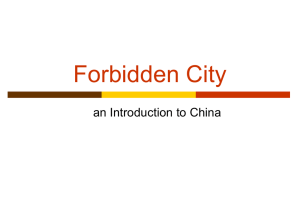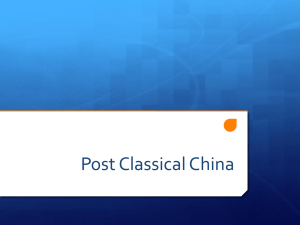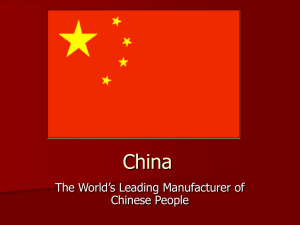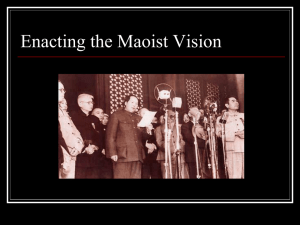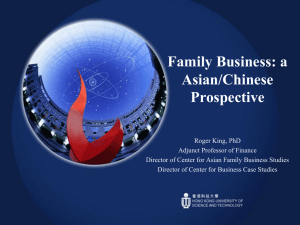I. STRUCTURE & PERSONNEL OF THE PROJECT 数据库的结构和
advertisement
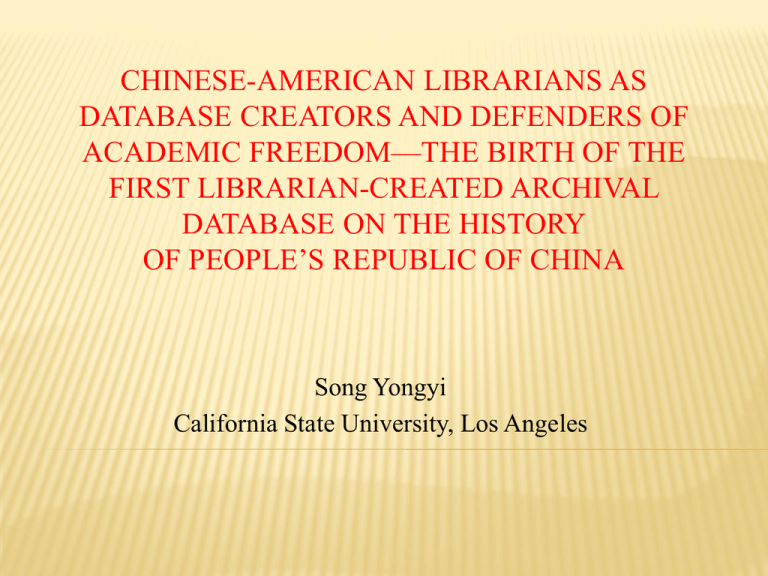
CHINESE-AMERICAN LIBRARIANS AS DATABASE CREATORS AND DEFENDERS OF ACADEMIC FREEDOM—THE BIRTH OF THE FIRST LIBRARIAN-CREATED ARCHIVAL DATABASE ON THE HISTORY OF PEOPLE’S REPUBLIC OF CHINA Song Yongyi California State University, Los Angeles I. STRUCTURE & PERSONNEL OF THE PROJECT 数据库的结构和人事 A. FOUR DATABASES 四个数据库 1. The Chinese Cultural Revolution Database 《中国文化大革命数据库》, covering from “Four Cleans” movement 四清 to the “Purging of Three Kinds of People” 清查三种人between 1963– 1985. 2. The Chinese Anti-Rightist Campaign Database 《中国反右运动数据库》, covering from“Movement to eliminate counter-revolutionaries”肃反 to Punishment and impact of the Anti-Rightist Campaign 反右后的处理 between 1955–1958. 3. The Chinese Great Leap Forward–Great Famine Databases 《中国大跃进-大 饥荒数据库》, covering from “State monopoly for purchasing and selling of agricultural products” 统购统销 to “Meeting of 7000” 七千人大会 between 1958–1962. 4. Database of the Chinese Political Campaign in the 1950s: from Land Reform to the State-Private Partnership between 1949-1956 《中国五十年代初中期的 政治运动数据库: 送土地改革到公私合营》. I. STRUCTURE & PERSONNEL OF THE PROJECT 数据库的结构和人事 B. STATISTICS & FORMAT 数据和形式 Database Title 数据库名 Publication Dates 出版时间 Edition 第几版 No. of Documents 共含文件数 The Chinese Cultural Revolution Database: 1966-1976 2002 (First edition) — Third 2014 6,748 The Chinese Anti-Rightist Campaign Database, 1957- 2010 (First edition) — Second 2013 10,101 The Chinese Great Leap Forward Great Famine Database, 1958-1962 2013 (First edition) — Second 2014 6,024 Database of Chinese Political Campaigns: from Land Reform to StatePrivate Joint Ownership, 1949-1956 2014 (First edition ) 9,072 First I. STRUCTURE & PERSONNEL OF THE PROJECT 数据库的结构和人事 B. STATISTICS & FORMAT 数据和形式 The database series has collected a total of 32,000 original archival documents 三万两千多份文件with approximately 107,460,000 一亿一千万左右的字 Chinese characters. Among them, CCP Party and internal documents account for about forty percent 大约40%是内部文件和档案. This historical series is the first and the largest database in the world on the history of political movements during the Mao Zedong era. It is a completely electronic database series that makes full use of the latest technologies in library and information science一个现代图书馆学和信息学的 电子数据库. As such, new sources are added on a monthly basis and large updates will be made annually 每月更新和加入新材料. Unlike traditional print publications, the databases in the series are searchable in both Chinese and English by subject, date, author, title, and keyword. They are also searchable by place, organization, and allow easy toggling between Chinese and English可以作主题词、关键词、作者、标题、地点、组织等 检索,有上述检索的中英文翻译. I. STRUCTURE & PERSONNEL OF THE PROJECT 数据库的结构和人事 B. STATISTICS & FORMAT 数据和形式 The online version of the database series (http:// ccrd.usc.cuhk.edu.hk) I. STRUCTURE & PERSONNEL OF THE PROJECT 数据库的结构和人事 B. STATISTICS & FORMAT 数据和形式 (主题检索) I. STRUCTURE & PERSONNEL OF THE PROJECT 数据库的结构和人事 B. STATISTICS & FORMAT 数据和形式 (地点检索) CD-ROM DATABASE FOR THE CULTURAL RVOLUTION CD-ROM DATABASE FOR ANTIRIGHTIST CAMPAIGN I. STRUCTURE & PERSONNEL OF THE PROJECT 数据库的结构和人事 B. STATISTICS & FORMAT 数据和形式 CD-ROM DATABASE FOR THE GREAT LEAP FORWARD AND GREAT FAMINE CD-ROM DATABASE FOR POLITICAL CAMPAIGNS IN THE 1950S I. STRUCTURE & PERSONNEL OF THE PROJECT 数据库的结构和人事 B. STATISTICS & FORMAT 数据和形式 I. STRUCTURE & PERSONNEL OF THE PROJECT 数据库的结构和人事 B. EDITORIAL BOARD 数据库编委会 (USA) Song Yongyi 宋永毅(Technical Service Librarian, California State University, Los Angeles, USA) Zhou Yuan 周原 Chicago, USA) Shen Zhijia 沈志佳 (Director of East Asian Library, University of Washington, Seattle, USA) Zhou Zehao 周泽浩 (Head of Archives, York College of Pennsylvania, USA) Guo Jian 郭建 (Professor, University of Wisconsin, Whitewater, USA) Ding Shu 丁抒 (Professor, Normandale Community College, USA) Wang Youqin 王友琴 (Professor, University of Chicago, USA) (Director of East Asian Library, University of Chicago, I. STRUCTURE & PERSONNEL OF THE PROJECT 数据库的结构和人事 B. ADVISORY BOARD 数据库顾问委员会 Jean-Philippe Béja (French Center for International Studies and Research) Michel Bonnin (Centre for the Study of Modern and Contemporary China, EHESS, France) Frank Dikotter (University of Hong Kong) Roderick MacFarquhar (Harvard University,USA) Edward Friedman (University of Wisconsin-Madison, USA) Li Rui 李锐 (former deputy head of the CCP Organization Department) Pei Minxin 裴敏欣 (Claremont McKenna College, USA) Perry Link (University of California, Riverside, USA) Qin Hui 秦晖 (Tsinghua University, China) Qian Liqun 钱理群 (Peking University, China) Vera Schwarcz (Wesleyan University, USA) Warren Sun 孙万国 (Monash University, Australia) Jonathan Unger (Australian National University) Andrew Walder (Stanford University, USA) Yang Jisheng 杨继绳 (deputy editor-in-chief of the Chinese history journal Yanhuang Chunqiu) Yu Yingshih 余英时 (Princeton University, USA) Xu Youyu 徐友渔 (Chinese Academy of Social Sciences, China) Zhu Zheng 朱正 (senior editor and independent scholar, China) II. INITIAL IMPERTUS AND CONTINUOUS MOTIVATION 启动的原因和继续的动力 A. INITIAL IMPETUS 起因 The initial impetus for embarking on this historic project was our desire to facilitate research on the Cultural Revolution for the academic community outside of China: we were well aware of the paucity of original sources for studying the Cultural Revolution. 海外文革研究缺乏原始资料 As survivors of the Cultural Revolution who pursued advanced education in the United States and considering most of us came to work in the library field, we felt called to take on this project. 文革经历者的责任 According to America Library Association’s Famous declaration of “The Freedom to Read Statement,” providing free access to information and preserving historical truth are every librarian’s “profound responsibility” and an essential “proposition” of our profession. 美国图书馆协会的宣言 II. INITIAL IMPERTUS AND CONTINUOUS MOTIVATION 启动的原因和继续的动力 B. CONTINUOUS MOTIVATION 继续的动力 Consistency: In the process of the Cultural Revolution database, we were astounded by the vicious consistency of the Chinese political movements throughout the Mao Zedong era. For instance,the massacre in Guangxi 广西 and the Dao county 道县 in Hunan province, it is not difficult to notice that the massacre strongly recalls the practices of the Land Reform in the early PRC in both content and form. 1) 文革“贫下中农最高法院”vs. 土改时期“人民 法庭”; 2)“追逼浮财”vs. 文革“抄家”…… Reoccurrence : The history of contemporary China is actually a history of political movements. Mao and the CCP used unending political movements as the primary form and means of ruling and managing the country(运动治国). But those top-down, large-scale violent mass movements were often with limited and short-term effectiveness, which exemplified by the frequent reoccurrence of political movements with the same name and contents. 1)永无 休止的“整风”运动: 1950-文革后期(如“批林整风”); 2)三次 “三反运动”(1952; 1953 “新三反”;1960);3)两次“五反运 动”(1952年针对民族资产阶级和1963年3月针对全社会)…… II. INITIAL IMPERTUS AND CONTINUOUS MOTIVATION 启动的原因和继续的动力 B. CONTINUOUS MOTIVATION 继续的动力 Enormity & Frequency: Our astonishment at not only the sheer enormity of the number of political movements, but also their amazing frequency. In just the first six years of the early People’s Republic of China (1949-1956), there were total about 43 campaigns which on average six to seven political campaigns a year. 征粮,减租、退押、清匪、反霸、土地改革、查田定产、党内整风、推 销公债、抗美援朝、全民捐献、镇压反革命、反政治谣言、反地方主义、宗 教三自运动 (自治、自养、自传)、思想改造、批判资产阶级倾向、清理 “中层”、“内层”、司法改革、清理积案、对党忠诚老实、民主改革、民 主改革补课、审干、三反 (反贪污、反浪费、反官僚主义)、增产节约、批 判《武训传》、新三反 (反对官僚主义、反对命令主义和反对违法乱纪)、 四反 (反行贿、反欺骗、反暴利、反偷漏)、五反(反行贿、反偷税漏税、 反盗骗国家资财、反偷工减料、反盗窃国家经济情报)、交待和资产阶级关 系、统购统销、批高(岗)饶(漱石)反党联盟、批胡风反革命集团、肃反、 批俞平伯的《红楼梦》研究、批胡适资产阶级唯心主义、批李四喜思想、农 业合作化、公私合营和手工业社会主义改造…… II. INITIAL IMPERTUS AND CONTINUOUS MOTIVATION 启动的原因和继续的动力 B. CONTINUOUS MOTIVATION 继续的动力 Humanitarian Disasters: Those political movements resulted the unprecedented cruelty and the humanitarian disasters. Notwithstanding the tens of millions of victims of myriad political movements, the Chinese Communist Party has been consistently illusive about the specific numbers of victims. 1) 按比例杀人的镇反运动 (“Campaign to Suppress Counterrevolutionaries” of 1951-1953):Initially, Mao had designated for execution was onethousandth of the total population(千分之一)。 However, In the top-secret telegram that Mao dispatched to the heads of major districts on April 20, 1951 titled “Instructions on the ratio of killings” 《关于杀人比例的指示》 one will notice that the actual rate of executions had risen to two-thousandth of the population (千分之二). Based on the estimated Chinese population in early PRC of around 450,000,000 to 500,000,000, there should have been approximately 900,000 to 1,000,000 “counterrevolutionaries” who were executed. II. INITIAL IMPERTUS AND CONTINUOUS MOTIVATION 启动的原因和继续的动力 B. CONTINUOUS MOTIVATION 继续的动力 2)按计划捕人杀人的肃反运动 (Campaign of Suppressing Counterrevolutionaries, 1955-):Along with the Five-Year Plan, CCP made a FiveYears Plan to arrest and execute counterrevolutionaries and other criminals. On August 13, 1955, the Ministry of Public Security produced a high classified document titled “Outline of the plan for arresting counterrevolutionary elements and criminals of all kinds across the country between 1955 and 1958” 《1955年 到1958年全国逮捕反革命分子和各种犯罪分子的计划纲要》, in which it planed to arrested total of 1,887,014—2,025,308 people. How ridiculous the plan was! No matter how absurd and laughable these incomprehensible “movements” may seem from today’s perspective, our conscience as scholars of Chinese descent compelled us to objectively preserve these historical documents through this database series so as to provide an opportunity for people today and people tomorrow to learn from history. As such, the significance of this database series is elevated from simply benefiting academic research to the preservation of the collective memory of a people and revelations of historical truth. III. RETURN BACK THE RIGHT TO KNOW ABOUT HISTORICAL TRUTH TO THE PEOPLE IN ADVANCE 提前还人民对历史真相的知情权 Maoist era was a history a half century ago but the government censorship treats it as a period with full “State secret.” Current CCP leadership has been taking increasingly repressive measures to discourage and prevent the complete disclosure of historical truth. Therefore, this kind of digital project cannot be conducted inside China. Our hope is that the database will make a contribution not only to the study of contemporary Chinese history, but also to the preservation of collective national memory and drawing lessons from history. III. RETURN BACK THE RIGHT TO KNOW ABOUT HISTORICAL TRUTH TO THE PEOPLE IN ADVANCE 提前还人民对历史真相的知情权 These seven scholars of the Maoist trove started with the “Great Proletarian Cultural Revolution,” the mother of all movements in its length, 10 years, and the massive disruption it caused in China. Their aim, as survivors of the Cultural Revolution, was to supply scholars with additional data for researching it. But as Song Yongyi explains in his preface, conscience and a sense of duty compelled them to chronicle previous movements. The Chinese Anti-Rightist Campaign Database, 1957- followed in 2010; The Chinese Great Leap Forward Great Famine Database, 1958-1962 followed in 2013; and their work concludes with this latest Database of Chinese Political Campaigns from Land Reform to State-Private Joint Ownership, 1949-1956. In total, the four databases comprise over 32,000 documents. For scholars and PhD students of modern China, these databases provide a magnificent starting block which …. the field owes a considerable debt of gratitude to Professor Song and his colleagues. Roderick MacFarquhar(马若德), Harvard University III. RETURN BACK THE RIGHT TO KNOW ABOUT HISTORICAL TRUTH TO THE PEOPLE IN ADVANCE 提前还人民对历史真相的知情权 这七位发掘毛时代文献资料的编者的工作是从“无产阶级文化大革命”开始的,这一运动历时 十年,在时间长度上可谓所有运动之母,并在中国造成了大规模的破坏。作为文化大革命的幸 存者,他们的目标是给学者们提供更多的研究资料。但如宋永毅在导言中所说,良知和责任使 他们把项目拓展到以往的运动。于是,(在2002年首次推出《中国文化大革命文库》之后), 2010年他们出版了《中国反右运动数据库,1957-》;2013年又出版了《中国大跃进-大饥荒数 据库,1958-1962》。他们的收尾之作是最新的《中国五十年代初期政治运动数据库:从土地 改革到公私合营,1949-1956》。这四个数据库共包含了32,000篇文件。这些数据库为学者和 博士研究生们进一步研究当代中国提供了一块宏大的奠基石。……而整个研究领域也因此欠下 了宋教授和他的伙伴们一份沉甸甸的感谢之情。 Roderick MacFarquhar(马若德), Harvard University CHINESE-AMERICAN LIBRARIANS AS DATABASE CREATORS AND DEFENDERS OF ACADEMIC FREEDOM— THE BIRTH OF THE FIRST LIBRARIAN-CREATED ARCHIVAL DATABASE ON THE HISTORY OF PEOPLE’S REPUBLIC OF CHINA Question?
